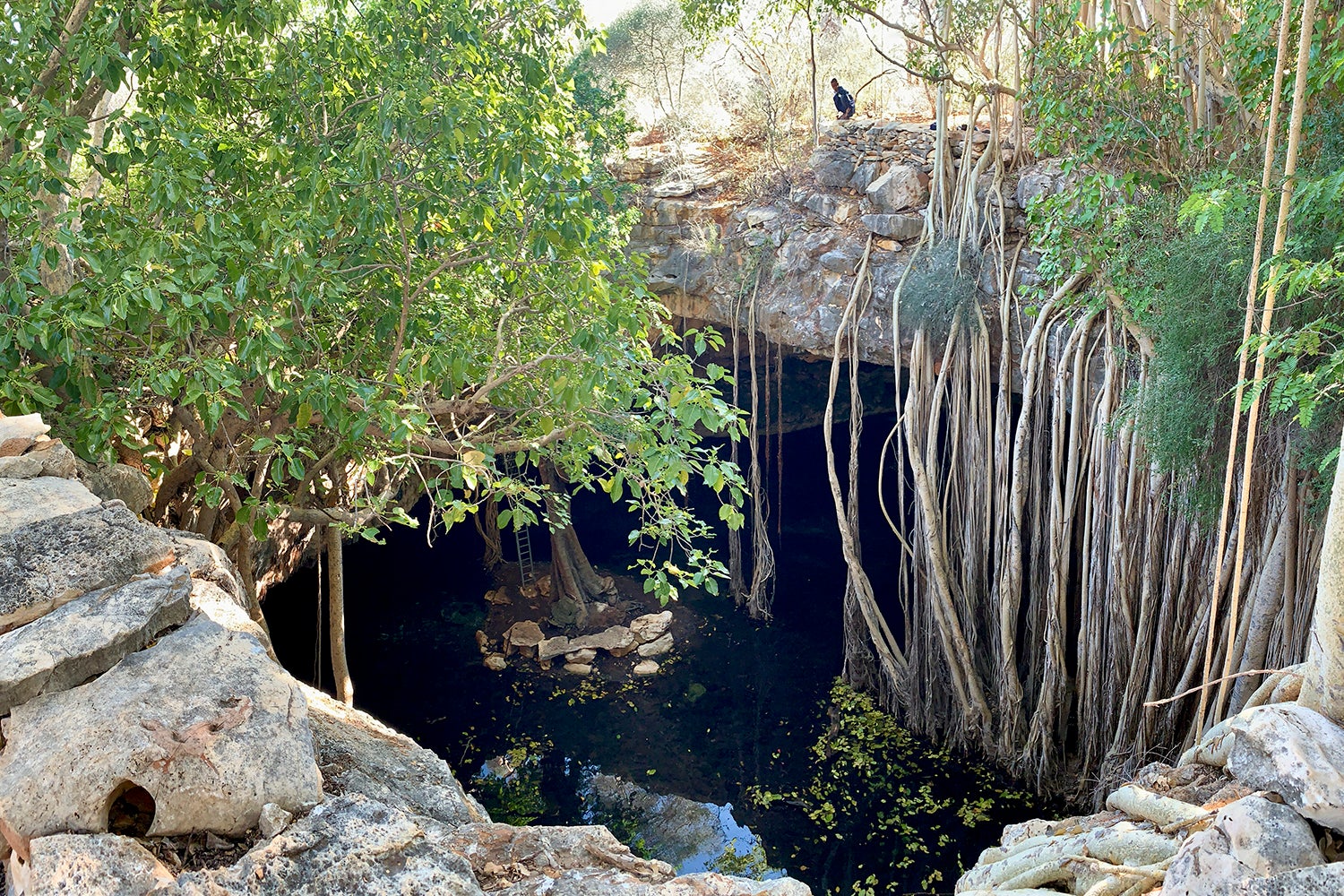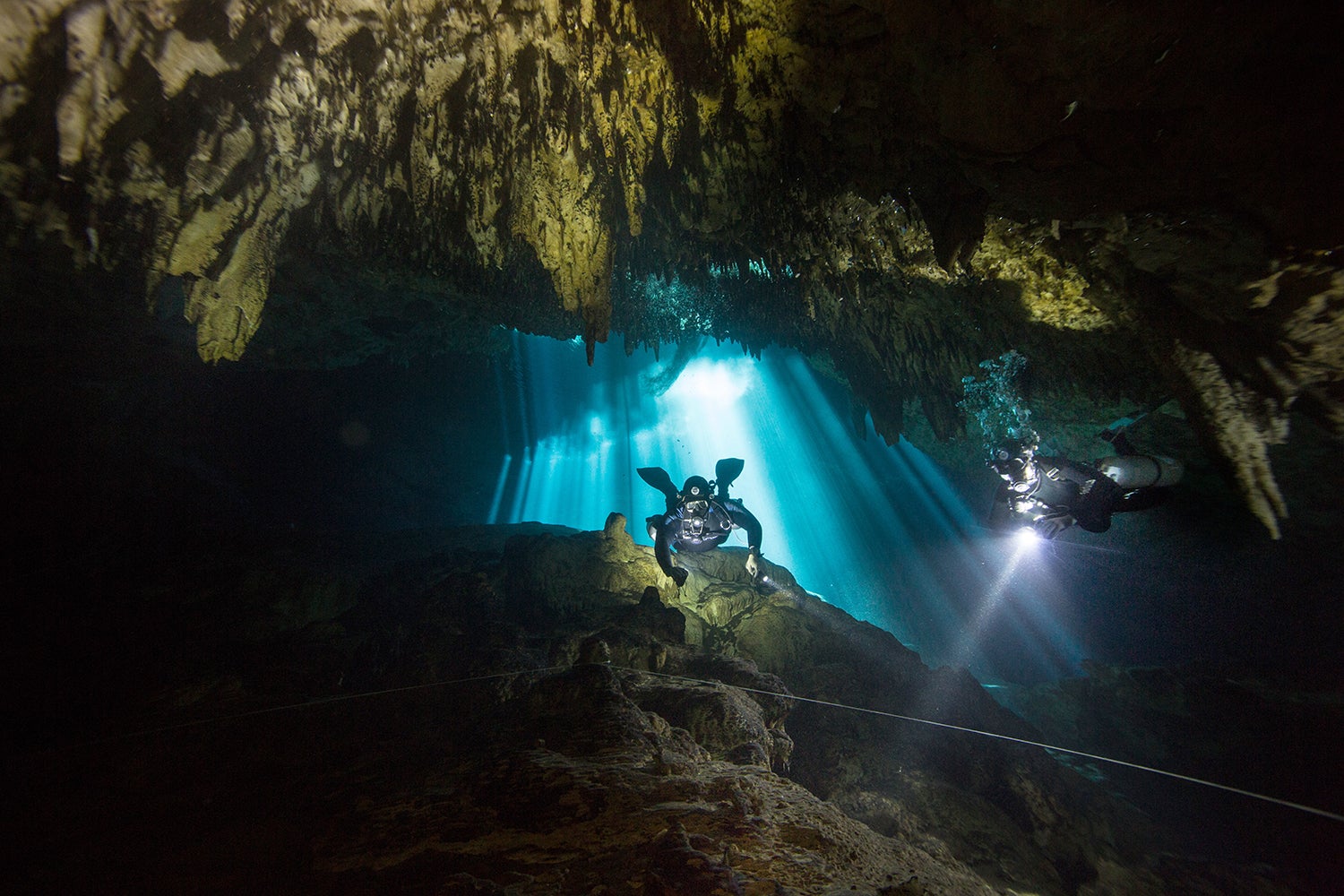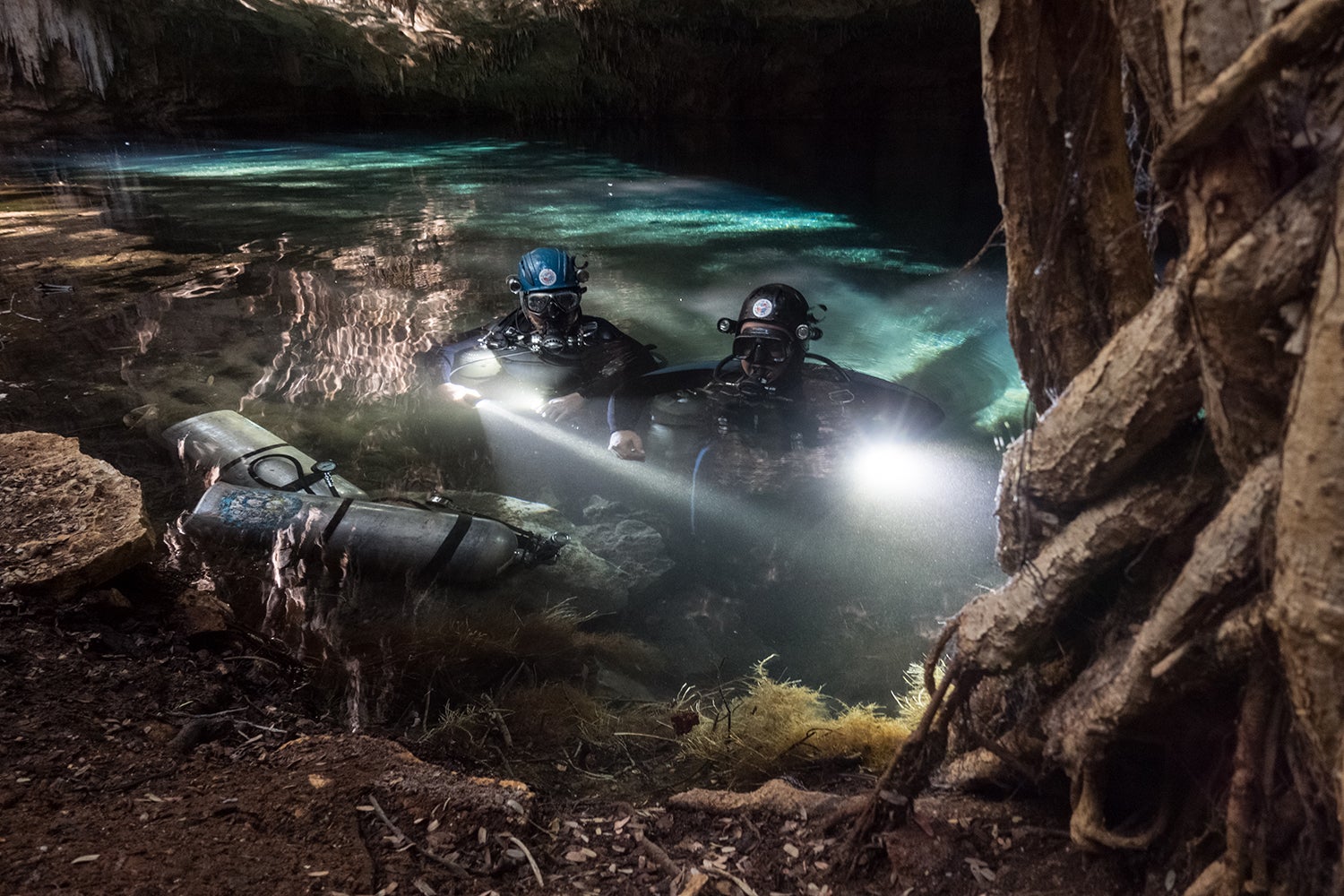Below Madagascar, cave divers surface secrets of the past
“WE DESCEND SLOWLY, the noise and busyness of the outside, and the light of day, dims behind us,” says Zachary Klukkert, making the scene at the mouth of the foreboding Vintany cave sound calm, almost meditative. At about 83°F, the waters are indeed soothing—nearly bathtub warm. But while the Central Michigan University anthropologist’s initial descent may drown out the chaos of the topside world, it leads him ever deeper, inch by inch, into a dark and stony maw.
His venture will take him nearly 100 feet beneath the surface of Madagascar, to the last resting place of giant lemurs, crocodiles with devilish horny protuberances, and some of the largest birds to ever walk the Earth. They’re remnants of a world that thrived here thousands of years ago, then vanished for reasons we’re still trying to understand. Back then, the spot’s winding limestone passages funneled the remains of such ancient creatures into mass graves. Now the very fissures and tunnels that gathered and trapped those relics are the only routes in and out for curious scientists.
Klukkert has been part of three expeditions to this spot near the western coast of Madagascar since 2016, but its layers and layers of fossils will likely take more than a decade to fully uncover. The stories in those bones may well be worth the trouble. Together, the skeletal pieces—and even the rocks of the cave itself—document life before and after humans arrived on the East African island. These specimens, perhaps more than any others yet found, are helping paleontologists understand why so many of this place’s immense and magnificent animals disappeared and how humans figured into that story.
 A member of the local surface team peers downward into Vintany cave, which paleontologists have explored since 2014. Zachary Klukkert
A member of the local surface team peers downward into Vintany cave, which paleontologists have explored since 2014. Zachary KlukkertMany of the bones left behind by the island’s exceptional primates, birds, and reptiles are less than 10,000 years old—falling into the category of “subfossils,” or ancient specimens that hail from after the end of the Ice Age. In fact, researchers eventually realized, many of these animals became extinct only after humans arrived. People traipsing around so close to a mass die-off seemed too perfect to be a coincidence. Then again, the disappearance of massive lemurs and towering birds also seemed to line up with harsh droughts.
For years, consensus on what had driven the extinctions seemed impossible to reach. But a diver’s chance discovery of bones beneath Vintany nearly a decade ago has given paleontologists a unique window through the murk of the past.
Scientists, in fact, have been collaborating with cavers to plumb the depths since at least the 1930s. “Caves can be excellent places to find fossils, because the bones of deceased animals often preserve very well within them, and they may be undisturbed,” says Laurie Godfrey, an anthropologist at the University of Massachusetts. Back in 1930, divers working with the Florida Geological Society found mastodon bones in caverns below the surface of the Aucilla River. More recently, in 2016, another group turned up the remains of a prehistoric human in Mexico’s Chan Hol cave. Two years later, another explorer discovered a trove of Pleistocene mammal bones in South Australia’s Mount Gambier system.
Vintany, though, is something special. Godfrey got recruited to study the site in 2014 by Alfred Rosenberger, an expert on the living and prehistoric monkeys of Central and South America. He’d just been on the receiving end of a thrilling dispatch from cave diver Phillip Lehman, who had previously helped him study fossilized primates in the Dominican Republic. Those first impressions were too good to sit on: Godfrey recalls that Lehman phoned Rosenberger in the middle of the night. “He had never seen so many fossils in an underwater cave,” she says.
“Every subfossil site tells its own story,” she says, and so “every site may yield secrets that others cannot.” She and her colleagues had already studied the dry caves in the region—a process that didn’t require air tanks, wetsuits, or much mortal peril—but the sheer number of specimens in the submerged site promised a view of the past the surface could never provide.
Lehman and Rosenberger set about assembling a team familiar with Madagascar, its fossils, and the caves below, including Godfrey, as an expert on the subfossil creatures, and Klukkert, then a new cave diver ready to take the plunge.
 Vintany isn’t as treacherous for divers as some caves, but even this relatively roomy descent requires expertise—and caution. Phillip Lehman
Vintany isn’t as treacherous for divers as some caves, but even this relatively roomy descent requires expertise—and caution. Phillip LehmanTo call his quest “dangerous” would be a gross understatement. All diving is risky, but submersion in cramped, pitch-black spaces severely compounds those risks. A flooded flashlight, a broken face mask, a ruptured air hose connection, or blinding clouds of kicked-up sediment can have grave consequences. Even highly trained explorers can run out of air if a spray of debris takes too long to settle. One 2015 study concluded that an average of three people perish while cave diving each year, but the actual number of fatalities could be even higher.
For some, the ever-present threat of disaster is likely the point. But Klukkert didn’t come to Vintany in search of subterranean thrills. There’s simply no other way to access the treasure trove. Crucially, the boneyard holds more than the secrets of the strange fauna of millennia past. The remains within Vintany, and even the stone of the cave itself, also speak to a much more urgent story—a tale of humans teaming up with ecological disasters to push life on Earth to the brink.
PREPPING TO DESCEND is a delicate balance between being ready for trouble and becoming so bogged down that it’s difficult to move—and easy to get hopelessly stuck. Klukkert learned this as a graduate student working on fossil primates found in the Dominican Republic’s underwater troves, where his diver colleagues rekindled a spark of fascination with underwater worlds he’d first felt as a kid in landlocked New Mexico. “Cave divers have a complicated relationship with equipment,” Klukkert says. The cave is too deep for a quick return to the surface, meaning a busted or misplaced piece of gear can derail a whole day of work—if it doesn’t kill you. So they need duplicates of all the essentials, like flashlights and face masks.
Then there’s the survey equipment to mark the locations of fossils, a camera to document the site, and plastic bins to hold specimens. “We place the bones into these small bins and carefully carry each full bin back to the surface individually to be sure that there isn’t any excess movement and avoid impacts with rocks on the way out,” Klukkert says. It’d be a shame for a lemur skull that’s survived for more than a thousand years to bite the dust moments after discovery.
 As divers prepare to descend from the surface, they must balance the need for preparedness with the increased peril that comes from towing excess gear. Phillip Lehman
As divers prepare to descend from the surface, they must balance the need for preparedness with the increased peril that comes from towing excess gear. Phillip LehmanThe script has played out more or less the same since the team’s first expedition to uncover the bones at Vintany in 2014—and for subsequent visits in 2016, 2018, and 2019. Once the crew reaches Madagascar, they travel three days by car and boat to get to their base of operations. Each day they load up trucks and spend a couple of hours driving in a caravan across dried-out lake beds and sand dunes to reach Tsimanampetsotsa National Park. The researchers and locally hired assistants then hike all their equipment half a mile to the dive site. It’s usually midday by the time they’re ready to take the plunge, which they’ll do once or twice a day for up to two weeks at a stretch.
At least sliding into the water is a relief from the heat, Klukkert says, which can break 90 degrees in the shade. He usually pauses briefly once his body is horizontal, waiting to ensure all his gear settles into place. In those moments, he says, the tension and worry give way to focus on the work ahead.
It may sound absurd to those who don’t spend time trapped in flooded dens, but Vintany is a relatively simple place to swim. The cave lacks the scary pinch points of some others, like a nearby cavern called Mitoho the divers have also explored. That spot, Klukkert says, “requires some vertical corkscrew maneuvers and some minor squeezes,” which can feel much tighter when your only air is strapped to your torso.
“There are times when I have to step back and make a decision about where to collect, recognizing that I can’t get it all.”
Even with a relatively roomy route, divers face a long list of potential disasters—and a tight schedule. Not only do they have to bring their own air, which is limited by space constraints to around four hours of breathing time, but the caves are deep enough to necessitate decompression stops to avoid the notorious “bends”—the effects of gas bubbles that form inside the body and can cause everything from joint pain to death.
The moment fins touch water, the clock starts ticking. Most of that time, Klukkert says, is spent mapping where the subfossils lie, providing essential context for experts trying to understand how such a graveyard came to be. The divers also stop to recover bits that seem especially interesting. Luckily, they don’t have to dig: Just waving a hand stirs the sediment on the cave floor to reveal the treasures beneath.
But that creates its own problem.
“The rising silt in the water reduces visibility and dims our powerful dive lights,” Klukkert says, which can obscure fossils. More importantly, it can make it difficult or impossible for them to see where they’re going. Knowing these delays are inevitable, the crew factors in time spent waiting for sediment to settle as part of the work.
By the time they finish, it’s near sunset—time to haul out any last finds, dry them, pack them up, and amble past the ring-tailed lemurs that sometimes come to watch their primate cousins bustle around the cave. The team starts the long drive back, then goes through a process Klukkert summarizes as “unload, eat, sleep, repeat.”
The sheer bounty is difficult to overstate: Vintany is so rich with bones that it’s impossible to get them all. During one trip down, divers were able to collect about 500 subfossils in just two hours. “There are times when I have to step back and make a decision about where to collect, recognizing that I can’t get it all, but I can’t cherry-pick either,” Klukkert says. It might save time to snag only specimens that look new and surprising, but even a common find can have major implications.
For example, Vintany is replete with Pachylemur insignis, an ancient lemur some four times heftier than modern species, and Voay robustus, a large horned crocodile. Researchers assumed that the reptile must have munched on primates, but it wasn’t until Klukkert found a particular Pachylemur skull that they found the evidence. “I fanned the teeth and palate to cleanse it of the extra bits still hanging on,” Klukkert says, “and that’s when I noticed that the teeth were brown, not white.” Later, after analysis, Godfrey and colleagues realized that the dark stain reflected the lemur’s violent end: Its modern relatives take on the same kind of dental hue when they’re eaten (and partially digested) by crocodiles. “This was the first sign of any direct interaction between the animals at our site,” Klukkert says, part of an ancient drama that likely played out over and over again.
PLUMBING THE DEPTHS of Vintany’s dark tomb tells us part of a broader story that may help us understand why Pachylemur and so many of Madagascar’s other unusual creatures disappeared. Paired with evidence from other sites around the island, such as butchered lemur bones and signs of human-introduced livestock, findings from the site and other caves have allowed Godfrey and colleagues to reconstruct what transpired on the island with a precision not seen before.
Take, for example, Vintany’s speleothems (the rock formations created by the drip, drip, drip of mineral-laden water). Researchers can use them to estimate past shifts in the local climate, knowing that they grow only when rain is plentiful. Analyzing the age of various speleothem lengths produces a reliable record of wet and dry stretches long past. By lining up these dates with the ages of fossils from Vintany—as well as specimens from other archaeological sites—Godfrey and colleagues have been able to track how closely weather shifts match up with the disappearances of elephant birds, pygmy hippos, and other fantastic beasts that once lived on the island.
 Divers make their way into the deepest portion of Vintany cave, which reaches some 140 feet beneath the surface of Madagascar. Phillip Lehman
Divers make their way into the deepest portion of Vintany cave, which reaches some 140 feet beneath the surface of Madagascar. Phillip LehmanEven though ideas about what triggered extinctions on Madagascar have often viewed ancient climate change and human activity as mutually exclusive options, the researchers found that what happened was not so clear-cut. Based on their findings, Godfrey and colleagues have come to suspect that the large animals around what’s now Tsimanampetsotsa began to die or migrate away during a drought about two thousand years ago. That didn’t totally topple the populations into oblivion, but it did thin their numbers. Another arid period would follow just a few hundred years later.
People arrived on the island shortly before the first deadly drought—about 2,500 years ago. They did butcher and eat the vulnerable animals, but didn’t immediately hunt them into nothingness. The real danger came from human land use. Just after the second major dry spell, the people began to grow crops from nonnative plants, raise cattle and pigs, and keep cats and dogs. These introduced species competed for space, food, and water with Madagascar’s native fauna, sometimes even preying on them. Already weakened by environmental change, many of the island’s most distinctive animals vanished.
Perhaps those amazing tortoises, crocodiles, hippos, birds, and primates would have survived our meddling if they had not been pummeled by inescapable droughts. Vintany confirms that both factors are part of the story—and both should serve as a warning for modern humans. Even species that seem to be faring well under our ecological influence may still be reduced, weakened, and stressed to the point where just one more bad year could push them over the edge. This lesson couldn’t be gleaned from the surface alone.
Vintany is far from the only cave to hold warnings about lost worlds. As-yet-unpublished findings on fossils from the Yucatán Peninsula’s Hoyo Negro may help paleontologists understand how Ice Age beasts and humans, like the teenager dubbed “Naia” found there in 2007, coexisted. Bones of a similar age in Australia’s Tank Cave could reveal how the continent’s car-size wombats and carnivorous koala cousins went extinct.
In these caverns—and in ones not yet discovered—history unfurls in a way rarely seen topside. “Being at a site is nothing like visiting a museum collection,” Klukkert says. Instead of cleaned bones in a box, a diver is greeted by remains of once-living things in their home habitat—precisely where death left them. It gives a sense of connection to a place and its history that can be hard to conceive of otherwise. The stories in Vintany and other watery graves are cautionary tales of our species’s interaction with nature—what Klukkert calls “a critical and unique resource for understanding the world that we live in as a product of how we live in it.”
This story originally ran in the Fall 2022 Daredevil Issue of PopSci. Read more PopSci+ stories.
Related Posts
By accepting you will be accessing a service provided by a third-party external to https://oc3anclub.com/

